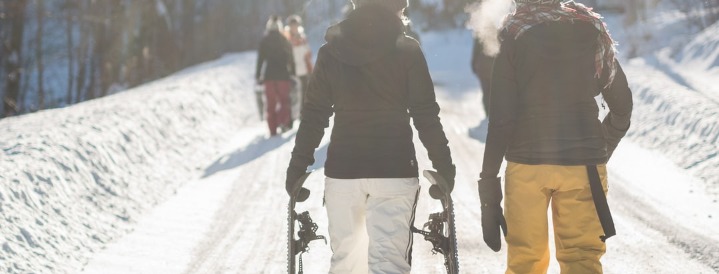A world-class ski resort and winter playground for Hollywood’s elite, Aspen is impressive by any standards. The luxury homes and condominiums help create an opulent, but warm and casual atmosphere in this Colorado getaway destination. Aspen is a city of festivals. January brings Winterskol, a great winter carnival, June sees the Food & Wine Classic in Aspen take over the town, and the famous Aspen Music Festival Summer Season is held from late June through August. The area hosts an impressive array of leisure activities in the summer including hang gliding, hiking, helicopter tours, mountain biking, and riding. In winter, every type of snow and ice sport can be found. The major ski resorts are Aspen Highlands, Aspen Mountain, and Aspen Buttermilk. For an unusual attraction, nearby Ashcroft Ghost Town and Independence Ghost Town provide a historic diversion. Maroon Bells, one of the most photographed mountains in America, is in the White River National Forest, a place ideal for picnics and hikes in the summer.
Mountains of Aspen
The four mountains in the Aspen area are close to each other, but not interconnected. A free shuttle runs from base to base. Here we cover Aspen Mountain, Aspen Highlands, Snowmass, and Buttermilk. ASC runs a very efficient equipment transfer program between its four mountains. For $5, you hand over your skis, poles or snowboard to an attendant in the base area at the end of the day, tell him/her where you’re skiing the next day, and your gear will be waiting for you at that base area the next morning. It works very well.
Beginners will have the most fun at Buttermilk. Intermediates probably will have a more varied day at Highlands, but the longest runs sweep down Aspen Mountain, and it’s hard to beat the exhilarating cruising on Buttermilk. Experts have a tossup between Highlands and Aspen Mountain. Our advice to snowboarders: Carvers, riders learning trees and terrain park tricksters should head to Buttermilk, seekers of the pow and steeps will want to beeline it to Aspen Mountain or Highlands.
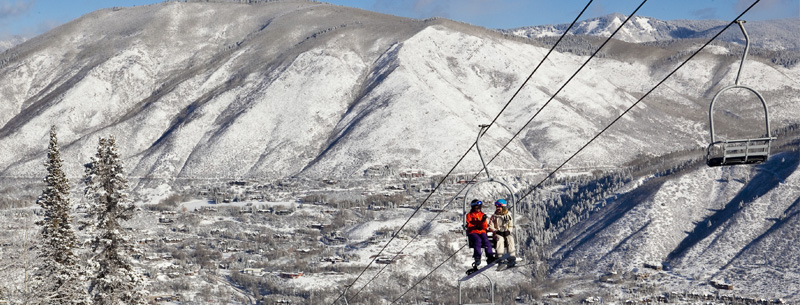
Aspen Ski Resort Facts
Dining: +++++
Apres-ski/nightlife: +++++
Other activities: +++++
Address: Aspen Skiing Company, P.O. Box 1248, Aspen, CO 81612
Ski area phone: 970-925-1220 or (800) 525-6200
Snow report: 970-925-1221 or (888) 277-3676
Toll-free reservations: (800) 262-7736 or 925-9000
Bed Base: 7,750; 13,050 within 10 miles
Nearest lodging: Slopeside, hotels, condos
Resort child care: 8 weeks and older
Aspen Expert & Advanced Ski Slopes
Highlands is the best-balanced mountain of the three with slopes for every level, and it’s the locals’ favorite. The vertical rise is one of the highest in Colorado. Three high-speed quads whisk you to the summit so you’re not wasting time on lifts.
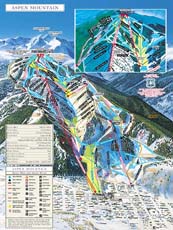 From the top of Loge Peak, the run back to the base is an uneven series of steeps, cat tracks, and gentle runouts. This mountain has some fantastic long cruises. The ridge, knifing directly to the summit, has thrilling pitches down both sides. Other than a few short blacks, such as Suzy Q and Limelight, the terrain makes a pronounced jump from intermediate to expert.
From the top of Loge Peak, the run back to the base is an uneven series of steeps, cat tracks, and gentle runouts. This mountain has some fantastic long cruises. The ridge, knifing directly to the summit, has thrilling pitches down both sides. Other than a few short blacks, such as Suzy Q and Limelight, the terrain makes a pronounced jump from intermediate to expert.
Experts should head for the steeps at the top of Loge Peak in the Steeplechase (sunny in the morning) and Olympic Bowl (sunny in the afternoon) areas. These are very steep with no bail-out areas, so be sure you want to be here. Both areas have long cat tracks back to lifts.
Some of Colorado’s steepest slopes stand above Loge Peak in Highland Bowl. You can reach the tops of the 40- to 45-degree slopes by hiking up the ridge for 20–60 minutes; or, if you happen to be at Loge Meadow between 11 a.m. and 1 p.m., hop on a free snowcat for a ride to the first access gate. The gladed runs here will keep you on your toes. The new Temerity triple means you can ski another 1,000 vertical feet down Highland Bowl and not hike out. This lift also accesses 180 new acres of chutes and trees. The tree chutes off Loge Peak are now double in length.
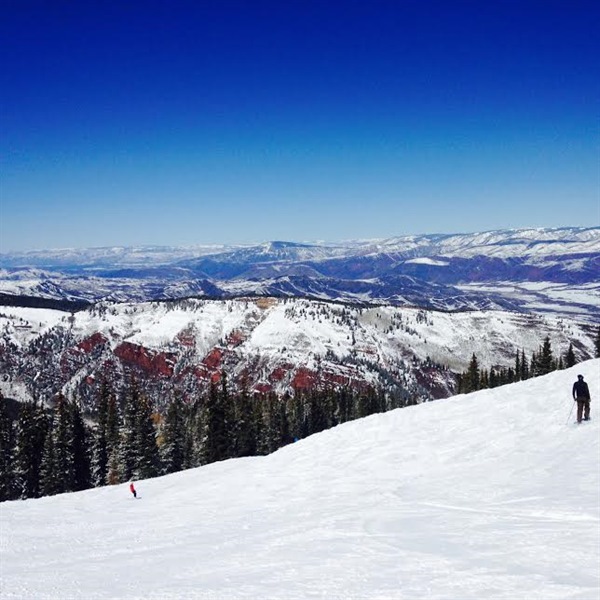
Also, check out the lower mountain. The Thunderbowl chair will take you from the base to the top of Bob’s Glades or Upper Stein, or you can drop into the double-black territory at several points along blue-square Golden Horn.
The basic guideline for Aspen Mountain is that the intermediate terrain is on the top knob around the summit and in the gullies between the ridges. The expert stuff drops from the ridges into the gullies. Of the blacks, take your pick and be sure you’re up to it. These runs are very black. For bumps and trees, Bell Mountain right under the gondola is a good choice. Watch for the ski patrol to open Walsh’s after a storm. It can be powder heaven, a run you can brag about all week. Guided “Powder Tours” are offered on the backside of Aspen Mountain; call (800) 525-6200 for information.
If you consider yourself a very confident advanced skier, read the expert section. If you feel you have recently reached an advanced status, read the intermediate section. In our experience, there’s a big jump from intermediate to expert terrain at Highlands and Aspen Mountain. Buttermilk’s marked advanced terrain is really more advanced-intermediate.
Aspen Intermediate Skiers
If you’d like to say you skied a black run on Aspen Mountain, Upper Little Percy or Red’s Run are occasionally groomed. The ticket office or the on-mountain Concierge Center at the summit has a grooming report (you can check this at all the mountains, by the way).
Unsure if you can handle the terrain? If you can ski blues at other areas, do this: Ride the gondola to the top and ski the gentlest terrain, at the summit—runs such as Dipsy Doodle, Pussyfoot and Silver Bell. Keep riding the Ajax Express and Gentlemen’s Ridge lifts. If any of those blue runs presents a challenge, ride back down in the gondola. The alternative to riding down is Copper Bowl or Spar Gulch, two narrow gullies that get packed late in the day as skiers funnel into them toward the base. Both runs join at Kleenex Corner—a sharp, narrow turn—then dump into Little Nell, a steep blue just above the gondola base. It’s known as “Little Hell” because at day’s end, it’s crowded, usually a little slick and/or moguled.
The blue cruisers—led by North American—inside of Bonnie’s outdoor deck are a delight. If you’re a confident intermediate, don’t pass up skiing at Aspen Mountain.
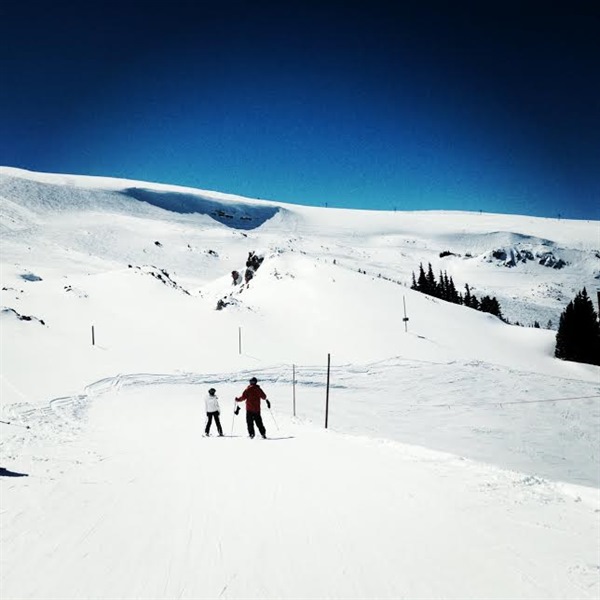
At Buttermilk, intermediates with confident turns will have fun on Jacob’s Ladder and Bear, which drop from the Cliff House to the main area, but the real playground is under the Tiehack chair. Much of this area is colored black on the trail map, but don’t get too excited—it’s just the toughest stuff on this mountain. You’ll discover good upper-intermediate trails that make inspiring cruisers. In one day you can ride the Upper Tiehack chair a dozen times, taking a different cruise on every 1,500 vertical-foot runs. Javelin is the best of the lot—a couple of tree islands to keep you awake and a lot of good dips and rolls. Smile in the evening when you overhear others scoffing about what a waste Buttermilk is for real skiers, and savor memories of 15,000 feet of vertical in just one afternoon.
At Highlands, intermediates will want to take these lifts: Cloud Nine, Olympic and Loge Peak. (The easiest of the intermediates are off Cloud Nine.) Don’t miss Golden Horn and Thunderbowl on the lower mountain, very wide cruisers.
Aspen Beginner & First-timer Slopes
Aspen Mountain may be the only ski mountain in America that has no designated green-circle runs. Don’t try it if you’re at this level.
Buttermilk is all that Aspen Mountain isn’t. Beginners can experience top-to-bottom runs as soon as they master snowplows. The beginner terrain concentrates under the Buttermilk West chair. Tom’s Thumb, Red’s Rover, Larkspur, Westward Ho and Blue Grouse will keep beginners improving. The Homestead Road turns back to the Savio chair and lazily winds its way to the Main Buttermilk area.
At Highlands, beginners are best served by trails from the Exhibition chair—Prospector, Nugget, Exhibition, Red Onion and Apple Strudel.
First-timers should take their first few lessons at Buttermilk. Of Aspen’s four mountains, this is by far the best for the first day on skis.
Aspen Snowboarding
At 673 acres, Aspen Mountain is not even one-fourth the size of Snowmass, but every acre is infinitely rideable. The mountain scenery is sublime—better, even than Telluride or Crested Butte. This is a mountain for expert riders who respect and even revere a pristine Alpine playground. There are no beginner trails and scant few true intermediate runs. But if you have good skills, the mountain is replete with bumps, steeps, natural halfpipes and terrain features perfect for riders.

If you measure the quality of your riding by the perfection of the “esses” and the depth of the trenches you leave behind, Buttermilk is the place for you. Buttermilk has numerous constant-pitch, top-to-bottom fall line, groomed runs ideal for laying out one perfect carve after another. Larkspur can be one of the most fun carving runs on the mountain, but you’ll go into the trees on either side if you don’t keep your turns tight. Carve Larkspur nonstop, top to bottom and we guarantee you’ll be high-fiving your buddies. The mountain gets interesting over on Racer’s Edge and Javelin; they’d probably be rated blues on other mountains, but they’re labeled black diamonds here. These runs get groomed and they’re steep enough to force even advanced riders to concentrate on working their edges. Cutting down from Tiehack Parkway are the Ptarmigan and Timber Doodle Glades. Here’s where intermediate boarders can learn to ride in the trees. The terrain is steep enough not to stall out, yet the trees are spaced far enough apart to learn. There also are a lot of runs at Buttermilk with gully-like sides that riders of all ages can swoop up and down, such as Bear.

Highlands attracts riders who are interested in riding blacks and double-blacks. While the resort’s quick to point out they actually have more green and blue terrain than black, if intermediate cruisers or a great terrain park is what you’re looking for, you’ll be happier at Snowmass or Buttermilk. Highlands is where advanced and expert riders go for steep on big powder days. Get ready for a spectacular descent in the 12,500-foot Highland Bowl, 100 or more turns in champagne powder up to your waist—or higher. Your best bet is to do it your first time with a guide who has ridden it several times before. The new Deep Temerity triple chairlift means no more heinous traverse back to the lift.
Parks and pipes
The wild side of Buttermilk is the top-to-bottom Playstation 2 Crazy T’rain Terrain Park. Nearly 2 miles long, it features 30 rails and the only 15-foot superpipe in the four Aspen mountains. It’s geared towards intermediates and better. At the bottom of the park, a gigantic kicker allows tricksters with huge, and we’re talking huge, air skills to put on a show for everyone at the base area. Hopefully, there’s an ambulance standing by. Highlands doesn’t have a halfpipe or terrain park; however, Prospector Trail is known locally as Grommets Gulch and is a natural halfpipe.
Just a few yards away from the Sundeck restaurant on Aspen Mountain, former competitive skateboarder and snowboarder Othello partners with Aspen Skiing Company to teach rail riding in Othello’s Rail Riders. Camp attendees learn how to get on a rail properly, how to balance and land, what not to do, tricks and terrain park etiquette. The camp also has a hut with video games, music, records, and DVDs. Reservations are required; call the ski and snowboard school. For a long cruiser that forms a wild natural halfpipe, there’s Spar Gulch, which cuts a steep “V” down the heart of the mountain to the patio of The Little Nell.
Cross-Country Skiing & Snowshoeing in Aspen
Aspen/Snowmass has the most extensive free Nordic trail system in America, more than 65 km. of groomed trails called “Aspen’s fifth mountain.” The Aspen Nordic Council‘s free system is accessible from Aspen or Snowmass and includes easy golf-course skiing as well as more difficult trails rising up to Snowmass.
In addition to the free trails provided by Aspen’s Nordic Council, Ashcroft Ski Touring Unlimited (925-1971) has 42 km. of groomed and set trails, and backcountry skiers can use summer hiking trails. Trail fees are $15 per day, and lessons and rentals are available.
Hut systems connect Aspen with Vail on the Tenth Mountain Trail and with Crested Butte over the Pearl Pass. Guides are available and recommended. Call Tenth Mountain Trail Association for more information, 925-5775.
Other centers are the Aspen Cross Country Center (544-9246) on the Aspen Golf Course off Hwy. 82; Ute Mountaineer (925-2849); Braun Hut System (925-6618), which has information on trails to Crested Butte; and Snowmass Club Cross Country Center (923-3148).
Snowshoeing is quite popular in town, so ask about those programs at any of the cross-country centers mentioned here. In conjunction with the Aspen Center for Environmental Studies (ACES), Aspen Skiing Company has naturalist-guided tours for $49 each day (including lift rides, equipment, and snack) on Aspen Mountain and Snowmass. Call 925-1220 or ACES at 925-5756 for reservations. You also can snowshoe up Aspen Mountain or Buttermilk at certain times and on certain runs. Ask an Aspen Skiing Company concierge about this.
Aspen Mountain Facts
- Summit elevation: 11,212 feet
- Vertical drop: 3,267 feet
- Base elevation: 7,945 feet
- Number of lifts: 8—1 gondola, 1 high-speed quad, 1 high-speed double, 2 quads, 3 doubles
- Snowmaking: 31 percent
- Skiable acreage: 673 acres
- Uphill capacity: 10,775 per hour
- Expert: ++++
- Advanced: +++++
- Intermediate: ++++
- Not recommended for beginners and first-timers
Buttermilk Facts
- Summit elevation: 9,900 feet
- Vertical drop: 2,030 feet
- Base elevation: 7,870 feet
- Number of lifts: 9—2 high-speed quads, 3 doubles, 4 surface lifts
- Snowmaking: 25 percent
- Skiable acreage: 435 acres
- Uphill capacity: 7,500 per hour
- Parks & pipes: 2 parks, 1 pipe
- Expert: +
- Advanced: ++
- Intermediate: ++++
- Beginner: +++++
- First-timer: +++++
Highlands Facts
- Summit elevation: 11,675 feet
- Vertical drop: 3,635 feet
- Base elevation: 8,040 feet
- Number of lifts: 5—3 high-speed quads, 2 triples
- Snowmaking: 14 percent
- Skiable acreage: 1,010 acres
- Uphill capacity: 6,500 per hour
- Parks & pipes: None
- Expert: ++++
- Advanced: +++++
- Intermediate: ++++
- Beginner: +++
- First-timer: ++
Snowmass, Colorado Ski Resort
Snowmass has grown from a condo and hotel village to a mountain resort town of nearly 2,000 year-round residents. It is built right along the slopes of one of Colorado’s biggest ski mountains.
Though it is lumped into the Aspen experience by geography, Snowmass stands on its own as a winter destination. Snowmass ranks among the top 10 resorts in America in size, and it’s the second-largest in Colorado (after Vail). It covers more than 3,100 acres—more than Aspen Mountain, Buttermilk and Highlands combined. And thanks to a surface lift to the top of the Cirque (formerly reached by a hike or snowcat), Snowmass lays claim to the longest vertical drop in the United States, 4,406 feet. (Big Sky, MT, has a 4,180-foot vertical; Jackson Hole, WY, 4,139 feet. Now you have your apres-ski bar conversation opener.)
The Snowmass Village Mall seems to stretch forever uphill with shops, restaurants, bars and skier services, but all are handicap accessible and if you are so inclined you can use hotel and public elevators (at 8,606 feet, you’ll soon know why we added this). The resort has started construction on its new base village, due for completion in 2012. Improvements in 2005/06 added a six-pack to replace the old Fanny Hill chair and a cabriolet lift to access beginner trails on Fanny Hill. The Elk Camp Gondola, new for 06/07, runs from the base of Fanny Hill to Elk Camp in 7.5 minutes.
Hundreds of condos line the lower part of the resort, and about 95 percent of the lodging is ski-in/ski-out. It doesn’t get much more convenient than Snowmass. A note to those staying in a ski-in/ski-out condo: Make note of where you are before you head down to the lift for your first run. We had a heck of a time knowing where to cut off from the ski run to our unit in a sea of brown condos at the end of the day.
Snowmass Ski Resort Facts:
Summit elevation: 12,510 feet
Vertical drop: 4,406 feet
Base elevation: 8,104 feet
Expert: ++++
Advanced: ++++
Intermediate: +++++
Beginner: +++
First-timer: ++
Dining: +++ (at resort)
+++++ (in the region)
Apres-ski/nightlife: ++ (at resort), +++++ (in the region)
Other activities: +++
Address: Aspen Skiing Company, P.O. Box 1248, Aspen, CO 81612 or Town of Snowmass Village, P.0. Box 5010, 51B Elbert Lane, Snowmass Village, CO 81615
Area code: 970
Ski area phone: 925-1220 or
(800) 525-6200
Snow report: 925-1221 or
(888) 277-3676
Toll-free reservations:
(800) Snowmass or
(800) 766-9627
Fax: 920-0771
E-mail: [email protected] (resort); or [email protected] (town)
Internet:
www.aspensnowmass.com (resort); or www.snowmassvillage.com (town); or www.stayaspensnowmass.com (lodging)
Number of lifts: 23—1 gondola, 1 cabriolet, 1 high-speed six-pack, 6 high-speed quads, 1 triple,
6 doubles, 4 surface lifts, 3 moving carpets
Snowmaking: 6 percent
Skiable acreage: 3,128 acres
Uphill capacity: 31,080 per hour
Parks & pipes: 3 parks, 2 pipes
Bed base: 6,000 rentable units
Nearest lodging: Slopeside, condos and hotels
Resort child care: Yes, 8 weeks and older
Adult ticket, per day:
$82 (06/07)
